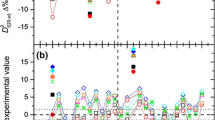Abstract
Recent developments in the UltraScan-III software make it possible to model multi-speed analytical ultracentrifugation sedimentation velocity experiments using finite-element solutions of the Lamm equation. Using simulated data, we demonstrate here how these innovations can be used to enhance the resolution of sedimentation velocity experiments when compared to single-speed experiments. Using heterogeneous systems covering as much as five orders of magnitude in molar mass and fivefold in anisotropy, we compare results from runs performed at multiple speeds to those obtained from single-speed experiments, fitted individually and analyzed globally over multiple speeds, and quantify resolution for sample heterogeneous in size and anisotropy. We also provide guidance on the design of multi-speed experiments and offer a program that can be used to deduce optimal spacing of rotor speeds and speed step durations when a few parameters from the experiment can be estimated. These include the meniscus position, the sedimentation coefficient of the largest species in a mixture, and a solute distribution. Our results show that errors observed in the determination of hydrodynamic parameters for system with great heterogeneity are markedly reduced when multi-speed analysis is employed.





Similar content being viewed by others
References
Brookes E, Demeler B (2007) Parsimonious regularization using GAs applied to the analysis of analytical ultracentrifugation experiments. GECCO Proceedings ACM 978-1-59593-697-4/07/0007
Brookes EH, Demeler B (2008) Parallel computational techniques for the analysis of sedimentation velocity experiments in UltraScan. Colloid Polym Sci 286:138–148
Brookes E, Boppana RV, Demeler B (2006) Computing large sparse multivariate optimization problems with an application in biophysics. In: Proceedings of the 2006 ACM/IEEE Conference on Supercomputing. Tampa, FL, USA. https://doi.org/10.1109/SC.2006.18
Brookes E, Cao W, Demeler B (2010) A two-dimensional spectrum analysis for sedimentation velocity experiments of mixtures with heterogeneity in molecular weight and shape. Eur Biophys J 39(3):405–414
Cao W, Demeler B (2005) Modeling analytical ultracentrifugation experiments with an adaptive space–time finite element solution of the Lamm equation. Biophys J 89(3):1589–1602
Demeler B (2010) Methods for the design and analysis of sedimentation velocity and sedimentation equilibrium experiments with proteins. Cur Protoc Prot Sci. https://doi.org/10.1002/0471140864.ps0713s60
Demeler B, Brookes EH (2008) Monte Carlo analysis of sedimentation experiments. Colloid Polym Sci 286:129–137
Demeler B, Gorbet G (2016) Analytical ultracentrifugation data analysis with UltraScan-III, Chap 8. In: Uchiyama S, Stafford WFT, Laue T (eds) Analytical ultracentrifugation: instrumentation, software, and applications. Springer, Japan, pp 119–143
Demeler B, Nguyen TL, Gorbet GE, Schirf V, Brookes EH, Mulvaney P, El-Ballouli AO, Pan J, Bakr OM, Demeler AK, Hernandez Uribe BI, Bhattarai N, Whetten RL (2014) Characterization of size, anisotropy, and density heterogeneity of nanoparticles by sedimentation velocity. Anal Chem 86(15):7688–7695
Gorbet G, Devlin T, Hernandez Uribe B, Demeler AK, Lindsey Z, Ganji S, Breton S, Weise-Cross L, Lafer EM, Brookes EH, Demeler B (2014) A parametrically constrained optimization method for fitting sedimentation velocity experiments. Biophys J 106(8):1741–1750
Gorbet GE, Mohapatran S, Demeler B (2018) Multi-speed sedimentation velocity implementation in UltraScan-III. Eur Biophys J. https://doi.org/10.1007/s00249-018-1297-z
Ma J, Zhao H, Sandmaier J, Alexander Liddle J, Schuck P (2016) Variable field analytical ultracentrifugation: II. Gravitational sweep sedimentation velocity. Biophys J 110(1):103–112
Rogge RA, Hansen JC (2015) Sedimentation velocity analysis of large oligomeric chromatin complexes using interference detection. Methods Enzymol 562:349–362. https://doi.org/10.1016/bs.mie.2015.05.007 (Epub 2015 Jun 29)
Stafford W (1992) Boundary analysis in sedimentation transport experiments: a procedure for obtaining sedimentation coefficient distributions using the time derivative of the concentration profile. Anal Biochem 203:295–301
Acknowledgements
This work was supported by NIH Grant GM120600 and NSF Grant NSF-ACI-1339649 (to BD). Supercomputer calculations were performed on Comet at the San Diego Supercomputing Center (support through NSF/XSEDE Grant TG-MCB070039N to BD) and on Lonestar-5 at the Texas Advanced Computing Center (supported through UT Grant TG457201 to BD).
Author information
Authors and Affiliations
Corresponding author
Additional information
Special Issue: 23rd International AUC Workshop and Symposium.
Electronic supplementary material
Below is the link to the electronic supplementary material.
Rights and permissions
About this article
Cite this article
Williams, T.L., Gorbet, G.E. & Demeler, B. Multi-speed sedimentation velocity simulations with UltraScan-III. Eur Biophys J 47, 815–823 (2018). https://doi.org/10.1007/s00249-018-1308-0
Received:
Revised:
Accepted:
Published:
Issue Date:
DOI: https://doi.org/10.1007/s00249-018-1308-0




